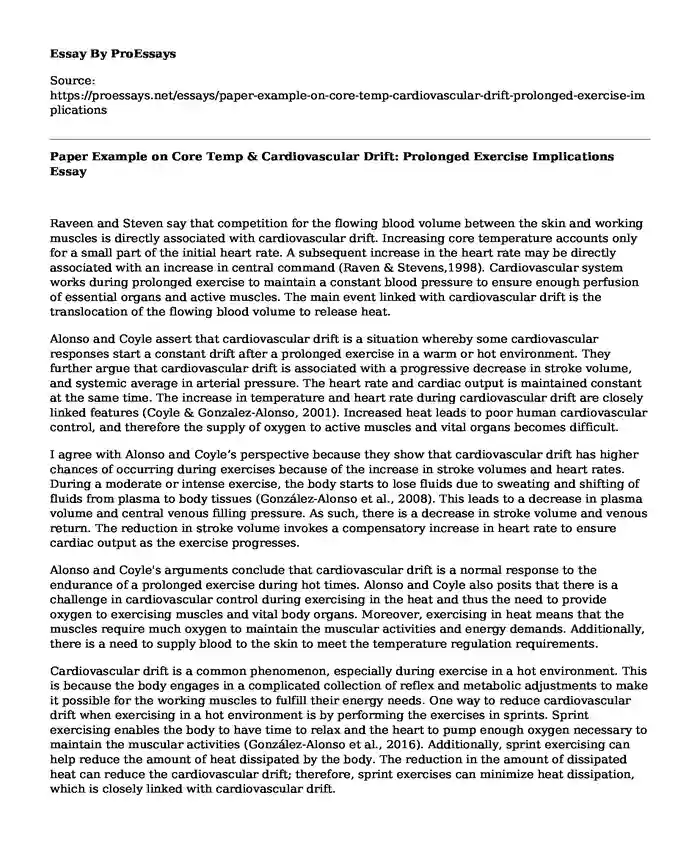Raveen and Steven say that competition for the flowing blood volume between the skin and working muscles is directly associated with cardiovascular drift. Increasing core temperature accounts only for a small part of the initial heart rate. A subsequent increase in the heart rate may be directly associated with an increase in central command (Raven & Stevens,1998). Cardiovascular system works during prolonged exercise to maintain a constant blood pressure to ensure enough perfusion of essential organs and active muscles. The main event linked with cardiovascular drift is the translocation of the flowing blood volume to release heat.
Alonso and Coyle assert that cardiovascular drift is a situation whereby some cardiovascular responses start a constant drift after a prolonged exercise in a warm or hot environment. They further argue that cardiovascular drift is associated with a progressive decrease in stroke volume, and systemic average in arterial pressure. The heart rate and cardiac output is maintained constant at the same time. The increase in temperature and heart rate during cardiovascular drift are closely linked features (Coyle & Gonzalez-Alonso, 2001). Increased heat leads to poor human cardiovascular control, and therefore the supply of oxygen to active muscles and vital organs becomes difficult.
I agree with Alonso and Coyle’s perspective because they show that cardiovascular drift has higher chances of occurring during exercises because of the increase in stroke volumes and heart rates. During a moderate or intense exercise, the body starts to lose fluids due to sweating and shifting of fluids from plasma to body tissues (GonzálezAlonso et al., 2008). This leads to a decrease in plasma volume and central venous filling pressure. As such, there is a decrease in stroke volume and venous return. The reduction in stroke volume invokes a compensatory increase in heart rate to ensure cardiac output as the exercise progresses.
Alonso and Coyle's arguments conclude that cardiovascular drift is a normal response to the endurance of a prolonged exercise during hot times. Alonso and Coyle also posits that there is a challenge in cardiovascular control during exercising in the heat and thus the need to provide oxygen to exercising muscles and vital body organs. Moreover, exercising in heat means that the muscles require much oxygen to maintain the muscular activities and energy demands. Additionally, there is a need to supply blood to the skin to meet the temperature regulation requirements.
Cardiovascular drift is a common phenomenon, especially during exercise in a hot environment. This is because the body engages in a complicated collection of reflex and metabolic adjustments to make it possible for the working muscles to fulfill their energy needs. One way to reduce cardiovascular drift when exercising in a hot environment is by performing the exercises in sprints. Sprint exercising enables the body to have time to relax and the heart to pump enough oxygen necessary to maintain the muscular activities (GonzálezAlonso et al., 2016). Additionally, sprint exercising can help reduce the amount of heat dissipated by the body. The reduction in the amount of dissipated heat can reduce the cardiovascular drift; therefore, sprint exercises can minimize heat dissipation, which is closely linked with cardiovascular drift.
Body hydration is another way that one can reduce cardiovascular drift. During the cardiovascular drift process, the body is deprived of fluids because of extensive sweating when performing an exercise on a hot day. The exercise leads to a shift in body fluids from the plasma to the tissues. As such, a body that is not well hydrated suffers severely from cardiovascular. Therefore, body hydration can help to maintain the correct balance of fluids during exercising. Thus, the body can avoid intense conditions and processes that lead to vascular drift.
References
Coyle, E. F., & Gonzalez-Alonso, J. (2001). Cardiovascular Drift During Prolonged Exercise: New Perspectives. Exercise and Sport Sciences Reviews, 29(2), 88-92.
GonzálezAlonso, J., Crandall, C. G., & Johnson, J. M. (2008). The cardiovascular challenge of exercising in the heat. The Journal of Physiology, 586(1), 45-53.
Raven, P. B., & Stevens, G. H. J. (1988). Cardiovascular Function and Prolonged Exercise.
Cite this page
Paper Example on Core Temp & Cardiovascular Drift: Prolonged Exercise Implications. (2023, Sep 22). Retrieved from https://proessays.net/essays/paper-example-on-core-temp-cardiovascular-drift-prolonged-exercise-implications
If you are the original author of this essay and no longer wish to have it published on the ProEssays website, please click below to request its removal:
- Essay Example on Public Health: Patient - Healthcare Professional Engagement
- Essay Sample on Cox Simulation Experience and Reflection
- Peer Reviewed Article: Health Care Issues for Veterans
- Policy, Government, and Law in the Prevention of Opioid Overdose
- How to Get Affordable Viagra Paper Example
- Human Dentition: An Analysis of Primary and Permanent Teeth - Essay Sample
- Research Paper on Hourly Rounding: Enhancing Patient Care in Hospitals







